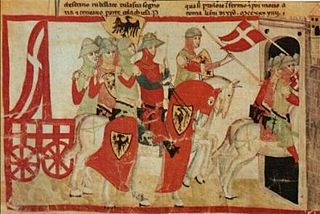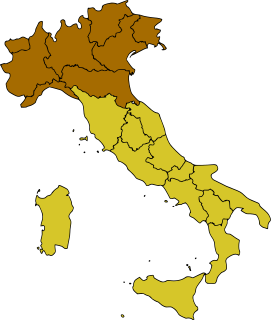Subject

The poem opens with a brief description of Milan's city walls, towers and gates; its public buildings, including the forum; and its paved streets and water supply. [1] [2] [4] [7] For example, lines 16–18 praise the city's "forum, with very beautiful buildings, and all its roads are solidly paved with blocks; it draws water for its baths through an aqueduct". [3] The reference to "solid paving" appears to conflict with archaeological evidence. [9]
In describing the city's buildings, the poet pays particular attention to the churches. [1] [2] [4] The bulk of the verses retell the spiritual history of Milan and discuss the characteristics of the Milanese church, including its unique Ambrosian rite. The poem praises the Milanese citizens for their piety and charitable nature, and expounds on their artistic and scientific successes. [1] [2] [4] [6] These virtues, together with their wealth and their close connection with the Lombard kings, are also cited in support of Milan's pre-eminence among the cities of northern Italy. [6] The poet then lists the many saints, martyrs and bishops buried within the city, stating that they are responsible for Milan's prosperity. [1] [2] [4]
The poet goes on to praise the Lombardian monarch, Liutprand, who reigned from 712 to 744, as well as the city's bishop, Theodore II, who died in 735. [1] [2] [4] [5] Aside from this mention of Liutprand, the poet does not refer to the state of Lombardy. [5] The poem concludes with a prayer. [1] [2] [4]
The subject matter is typical of later medieval Christian urban eulogies. [1] It expresses the unknown author's sense of civic pride. [2] [4] [5] The choice of topics and their organisation follow the classical scheme of a eulogy to a city, originating in Ancient Greece and commonly practised in Ancient Rome. [1] [2] The poet might have followed an 8th-century guide to the form called De laudibus urbium, adapting it to his Christian perspective. [2] [4] [8] He does not seem to have been inspired by Ausonius's earlier poem. [4]
Several scholars have suggested that the Laudes Mediolanensis civitatis might be the contribution of Milan, the ecclesiastical capital of Italy, to a literary rivalry with the royal capital, Pavia. Nicholas Everett has pointed out that Milan is described as "the queen of towns, mother of the realm ... who bears the eminent title of metropolis. The immense dignity of her power endures, so that all the bishops of ancient Italy [presules Ausoniae] come to her to be instructed according to the dictates of canon law." [10] Pavia also had a canon law school. Giovanni Battista Pighi (it), one of the poem's editors, and Gina Fasoli (it) have argued that the poem inflates Milan's contemporary importance by a set of clever overstatements; for example, it was not the "urbs regia" and had not been the administrative capital since the end of the 4th century. The poem's opening also stresses that Milan's name stretched back into antiquity, while Pavia was then known by two different names, "Papia" and "Ticinum". [2]












